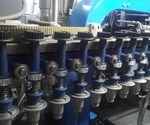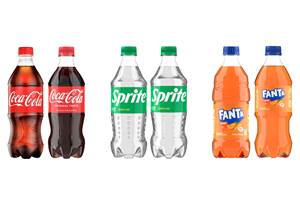When the preform is stretched into the blow mold, the vestige of the injection molding process, mostly referred to as a gate, must be placed and held in the center of the bottom insert of the mold. If this does not happen, the side to which the gate is pushed becomes thicker, and, consequently, the other side will be thinner. This is simply the effect of shorter and longer paths of the preform wall to reach the blow mold wall.
With bottles becoming lighter and thinner as a result of cost-cutting measures as well as environmental concerns (“carbon footprint”), the drive to reduce the resulting wall-thickness variances is ever more paramount for a successful PET bottle operation.
There are a number of reasons the gate may go off-center. Listed in no particular order, they are:
• Incorrect Stretch Rod Adjustment: The stretch rod must push and securely hold the preform to the bottom insert. This is accomplished by adjusting the stretch rod about 1 mm (0.040-in.) lower to the base than the thickness of the preform at the gate.
• Pre-Blow Pressure Too Early and/or Too High: As the stretch rod descends, pressure lower than the final blow pressure is activated to prevent the preform from collapsing and to impart a desired wall thickness to various regions of the bottle. If the pressure comes on early and is high enough to push the preform off the rod, the gate will always go off-center. A test without high-pressure blow, the so-called “pre-blow audit,” can reveal this problem, which is easily fixed by reducing the pre-blow pressure or delaying its onset. The pre-blow audit will reveal the correct pressure to inflate the preform to form a bubble but not yet reaching the mold walls.
• Preform Bent Before Stretching: This problem is most often found in single-stage stretch-blow molding when the preform has uneven heat around its circumference imparted by the hot runner. In this case the heater bands should be examined and possibly turned to ameliorate it. If it happens in two-stage molding, see the next bullet point.
• Preforms Not Rotating Completely in the Oven: There are two systems in place to guarantee rotation of the preforms:
1. Actively rotating a gear on a chain that is connected to the mandrel. This is most often used in machines where the preforms travel though the ovens upside down.
2. Passive rotation by letting a gear (often made of plastic) connected to the mandrel slide along a grooved belt, forcing rotation. This is more commonly used on modern machines. In either case it is important that the engagement of the gear is guaranteed over the entire oven length. But engagement cannot be too much, as pushing against the gear would put stress on the bearings leading to premature failure.
Over time the bearings may slowly fail or be impacted by dirt or oil, and some of the mandrels may not turn all the time. It is also possible that the belt will have some slack in certain spots and be fine in others. This can be hard to spot, as the areas inside the oven where this happens may be visible only when certain covers have been removed. The result, however, can be dramatic. When one side of the preform stays much colder than the other, it can—and will—rip the gate vestige out of the base-insert well, even when there is 1-mm interference between stretch rod and base insert.
This problem may be hard to find because the rotation may be inconsistent with only a few spindles sometimes involved. This leads then to intermittent problems in possibly a number of cavities:
• Preforms Not Concentric on the Spindles: A similar problem occurs when the preforms “wobble” on the mandrels. This is typical on machines where preforms travel upside down on simple mandrels whose diameter must be smaller than the smallest preform ID in order not to cause infeed jams. Machines where preforms travel right-side up must have better holders to prevent the preforms from falling down. As a side effect, these holders also make sure the preforms rotate evenly. There are a number of designs, most of which consist of three or four segments that have some elasticity to accommodate tolerances in preform IDs.
• Well in Bottom Insert Missing: Every bottom insert of the mold must have a well to accommodate the vestige of the injection process. Only with a well can it be avoided that the gate slips on the curved surface of the bottom insert.
ABOUT THE AUTHOR: Ottmar Brandau has been working in the Plastics industry since 1978, and is the president of Apex Container Tech Inc. His latest book. The Rapid Guide to Perfect PET Bottles, describes 31 common defects and their solutions. Contact: 705-429-1492; apex@blowmolding.org; blowmolding.org/shop.Related Content
At NPE, Cypet to Show Latest Achievements in Large PET Containers
Maker of one-stage ISBM machines will show off new sizes and styles of handled and stackable PET containers, including novel interlocking products.
Read MoreAdding Remote Service Functions for PET Bottle Blowing
KHS has added features to its internet machine communications portal for PET stretch-blow molding.
Read MoreAll-Electric Shuttle and Stretch-Blow Machines
NPE2024: Meccanoplastica shows off a double-sided shuttle for containers up to 5 L and a reheat stretch-blow molder for up to 2.5 L PET containers with four cavities — both all-electric.
Read MoreCoca-Cola’s Redesign of Small PET Bottles Pushes Lightweighting Below Prior ‘Floor’
Coca-Cola thought it had reached the limits of lightweighting for its small PET carbonated soft drink bottles. But a “complete redesign” led to a further 12% reduction.
Read MoreRead Next
Lead the Conversation, Change the Conversation
Coverage of single-use plastics can be both misleading and demoralizing. Here are 10 tips for changing the perception of the plastics industry at your company and in your community.
Read MoreFor PLASTICS' CEO Seaholm, NPE to Shine Light on Sustainability Successes
With advocacy, communication and sustainability as three main pillars, Seaholm leads a trade association to NPE that ‘is more active today than we have ever been.’
Read More























